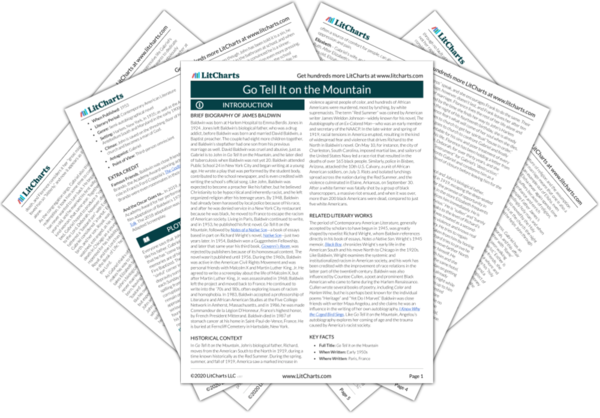Music takes on a twofold meaning in Go Tell It on the Mountain: depending on the genre, music represents both morality and immorality, redemption and sin. On the one hand, hymns and gospel songs—artifacts of religion—represent spiritual purity and moral perfection. The novel’s title is a reference to a popular African American spiritual song, and the novel’s characters are brought closer to God through songs and music. Music is a major part of church and tarry services at the Temple of the Fire Baptized, and even when Florence has forgotten how to pray, she can still remember the words to her mother, Rachel’s, favorite gospel song, “Standing in the Need of Prayer.” The music of the Temple of the Fire Baptized has “been with John, so it seemed, since he had first drawn breath,” and it “caused him to believe in the presence of the Lord.” But John only reluctantly sings in church and refuses to clap or dance; he believes himself a sinner and thus doesn’t think he has the “right to sing or rejoice,” further suggesting that religious songs represent spiritual and moral purity in the novel.
As gospel music and hymns are symbolic of God and religion, jazz music and rhythm and blues are symbolic of sin and immorality. The “sinners” who frequent the whiskey houses and gin joints near John’s Harlem church listen to the blues, and blues music is frequently associated with “harlots” and whorehouses in the novel. Frank, Florence’s ex-husband, who was, according to Florence, “determined to live and die a common [n_____],” “drank too much” and “sang the blues”—from Florence’s perspective, Frank’s penchant for the blues was reflective of his immorality.
However, despite what his characters may think, Baldwin forces his readers to reevaluate “sinners” in relation to popular stereotypes of immorality, like listening to the blues or jazz, and suggests that this music isn’t sinful in and of itself. Baldwin frequently references the spiritual song, “I Looked Down the Line (And I Wondered),” by Sister Rosetta Tharpe. Sister Tharpe’s unique blend of gospel and the blues was wildly popular in the 1930s and ‘40s, and she was one of the very first cross-over acts, successfully performing her spiritual songs at jazz clubs and dance halls across America. Through references to the music of Sister Tharpe and others, Baldwin suggests that one can be both moral and sing the blues.
Music Quotes in Go Tell It on the Mountain
I looked down the line,
And I wondered.
It seemed that he could not breathe, that his body could not contain this passion, that he would be, before their eyes, dispersed into the waiting air. His hands, rigid to the very fingertips, moved outward and back against his hips, his sightless eyes looked upward, and he began to dance. Then his hands closed into fists, and his head snapped downward, his sweat loosening the grease that slicked down his hair; and the rhythm of all the others quickened to match Elisha’s rhythm; his thighs moved terribly against the cloth of his suit, his heels beat on the floor, and his fists moved beside his body as though he were beating his own drum. And so, for a while, in the center of the dancers, head down, fists beating, on, on, unbearably, until it seemed the walls of the church would fall for very sound; and then, in a moment, with a cry, head up, arms high in the air, sweat pouring from his forehead, and all his body dancing as though it would never stop. Sometimes he did not stop until he fell—until he dropped like some animal felled by a hammer—moaning, on his face.












